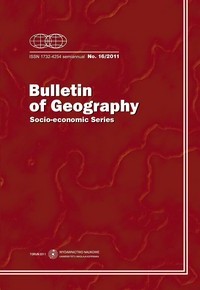Changes in population and economy in Śląskie voivodship in the context of the suburbanization process
Changes in population and economy in Śląskie voivodship in the context of the suburbanization process
Author(s): Franciszek Kłosowski, Jerzy RungeSubject(s): Social Sciences
Published by: Wydawnictwo Naukowe Uniwersytetu Mikołaja Kopernika
Keywords: Poland; Śląskie voivodship; Katowice conurbation; Rybnik agglomeration; Bielsko-Biała agglomeration; Częstochowa agglomeration; suburbanization
Summary/Abstract: This paper attempts to determine and describe suburbanization stages (especially in the context of political-economic transformations and population changes) and also, to verify classical models of urbanization stages as a system of concentric zones, basing on historical process of development of complex settlement systems of Katowice voivodship (according to the former administrative division), i.e., Katowice conurbation, Rybnik agglomeration, Bielsko-Biała agglomeration, and Częstochowa agglomeration. The analysis includes the population number and the balance of migration between 1975 and 2008, as well as the number of entities of national economy between 1995 and 2008. Every settlement system was divided into its core, such as the main city or a group of cities, and its surrounding area, comprising urban and rural municipalities directly neighbouring the core. The calculations included absolute single-base increments and chain increments. The analysis showed that the historical processes of urbanization of the Śląskie voivodship reveal significant variations in the way they were shaped in comparison with model-based approaches included in the literature of the subject matter. The agglomeration of Częstochowa is the closest to the concentric model, consisting of urbanization, suburbanization and deurbanization, whereas the remaining settlement systems reveal bigger or smaller differences. Variations between analyzed settlement systems reveal themselves also in contemporary times. The rate of population growth and migration balances divide the systems into different stages of maturity of suburbanization. The earliest were discovered in the Katowice conurbation. As much as the rate of population changes and migration balances significantly differentiated the core areas in comparison with their surroundings, the differences were less obvious in the aspect of business growth rate. This results from the fact that the core areas still retain the majority of workplaces. An increase of business activity around the surrounding areas remains selective, both as to the kind and space, revealing somehow higher rate as far as the agglomeration of Bielsko-Biała is concerned
Journal: Bulletin of Geography. Socio-economic Series
- Issue Year: 2011
- Issue No: 16
- Page Range: 89-106
- Page Count: 18
- Language: English

